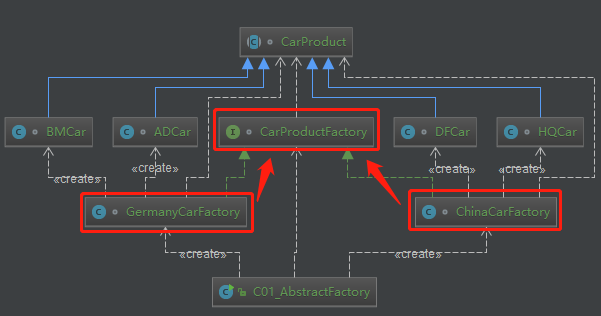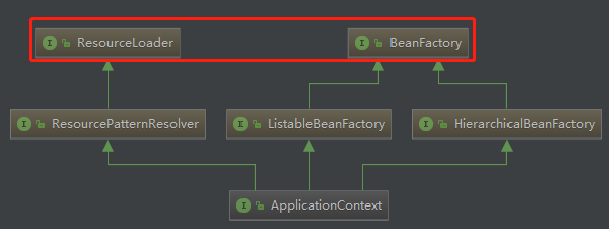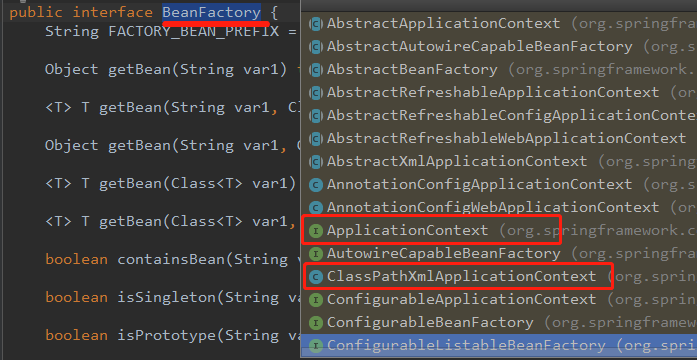本文源碼:GitHub·點這裏 || GitEE·點這裏
一、抽象工廠模式
1、生活場景
汽車生產根據用戶選擇的汽車類型,指定不同的工廠進行生產,選擇紅旗轎車,就要使用中國工廠,選擇奧迪轎車,就要使用德國工廠。
2、抽象工廠模式
1) 抽象工廠模式:定義了一個interface用於創建相關對象或相互依賴的對象,而無需指明具體的類;
2) 抽象工廠模式可以將簡單工廠模式和工廠方法模式進行整合;
3) 從設計層面看,抽象工廠模式就是對簡單工廠模式的改進(或者稱爲進一步的抽象)。
4) 將工廠抽象成兩層,AbstractFactory(抽象工廠) 和 具體實現的工廠子類,方便程序擴展。
3、代碼UML圖
4、源代碼實現
/**
* 抽象工廠模式
*/
public class C01_AbstractFactory {
public static void main(String[] args) {
CarProductFactory factory = new ChinaCarFactory() ;
factory.getCar("hq") ;
factory = new GermanyCarFactory () ;
factory.getCar("ad") ;
}
}
// 汽車生產抽象工廠
interface CarProductFactory {
CarProduct getCar (String type) ;
}
// 中國汽車工廠
class ChinaCarFactory implements CarProductFactory {
@Override
public CarProduct getCar(String type) {
CarProduct product = null ;
if ("hq".equals(type)){
product = new HQCar() ;
product.name="紅旗一號" ;
product.date="1999-09-19" ;
product.material();
product.origin();
} else if ("df".equals(type)){
product = new DFCar() ;
product.name="東風一號" ;
product.date="2019-09-19" ;
product.material();
product.origin();
}
return product ;
}
}
// 德國汽車工廠
class GermanyCarFactory implements CarProductFactory {
@Override
public CarProduct getCar(String type) {
CarProduct product = null ;
if ("ad".equals(type)){
product = new ADCar() ;
product.name="奧迪A8" ;
product.date="2017-09-19" ;
product.material();
product.origin();
} else if ("bm".equals(type)){
product = new BMCar() ;
product.name="寶馬X8" ;
product.date="2018-09-19" ;
product.material();
product.origin();
}
return product ;
}
}
// 汽車生產抽象類
abstract class CarProduct {
/**
* 汽車名稱
*/
protected String name ;
/**
* 生產日期
*/
protected String date ;
/**
* 材料
*/
abstract void material () ;
/**
* 產地
*/
abstract void origin () ;
}
// 紅旗車
class HQCar extends CarProduct {
@Override
void material() {
System.out.println(super.name+"材料...");
}
@Override
void origin() {
System.out.println(super.date+":"+super.name+"在中國北京生產");
}
}
// 東風車
class DFCar extends CarProduct {
@Override
void material() {
System.out.println(super.name+"材料...");
}
@Override
void origin() {
System.out.println(super.date+":"+super.name+"在中國南京生產");
}
}
// 奧迪車
class ADCar extends CarProduct {
@Override
void material() {
System.out.println(super.name+"材料...");
}
@Override
void origin() {
System.out.println(super.date+":"+super.name+"在德國柏林生產");
}
}
// 寶馬車
class BMCar extends CarProduct {
@Override
void material() {
System.out.println(super.name+"材料...");
}
@Override
void origin() {
System.out.println(super.date+":"+super.name+"在德國慕尼黑生產");
}
}二、Spring框架應用
1、場景描述
Spring框架中獲取配置文件中Bean的多種方式。
2、核心配置
<bean id="carBean" class="com.model.design.spring.node04.abstractFactory.CarBean">
<property name="name" value="中國紅旗" />
</bean>
<bean id="carBean1" class="com.model.design.spring.node04.abstractFactory.CarBean">
<property name="name" value="德國奧迪" />
</bean>3、測試文件
這裏使用了兩種方式獲取。
@RunWith(SpringJUnit4Cla***unner.class)
@ContextConfiguration(locations = {"classpath:/spring/spring-abstract-factory.xml"})
public class SpringTest {
@Resource
private BeanFactory beanFactory ;
@Test
public void test01 (){
CarBean carBean = (CarBean)beanFactory.getBean("carBean") ;
System.out.println(carBean.getName());
}
@Test
public void test02 (){
ApplicationContext context01 = new ClassPathXmlApplicationContext(
"/spring/spring-abstract-factory.xml");
CarBean carBean = (CarBean)context01.getBean("carBean1") ;
System.out.println(carBean.getName());
}
}4、結構分析
抽象工廠封裝對象的創建。在Spring中,通過實現BeanFactory。可以從Spring的各種容器獲取bean。根據Bean的配置,getBean方法可以返回不同類型的對象(單例作用域)或初始化新的對象(原型作用域)。在BeanFactory的實現中,我們可以區分:ClassPathXmlApplicationContext,XmlWebApplicationContext等。
三、工廠模式小結
三種工廠模式 (簡單工廠模式、工廠方法模式、抽象工廠模式),工廠模式的核心用意將實例化對象的代碼封裝起來,放到工廠類中統一管理和維護,完成代碼依賴關係的解耦。從而提高程序的可擴展性和維護性。
四、源代碼地址
GitHub·地址
https://github.com/cicadasmile/model-arithmetic-parent
GitEE·地址
https://gitee.com/cicadasmile/model-arithmetic-parent



